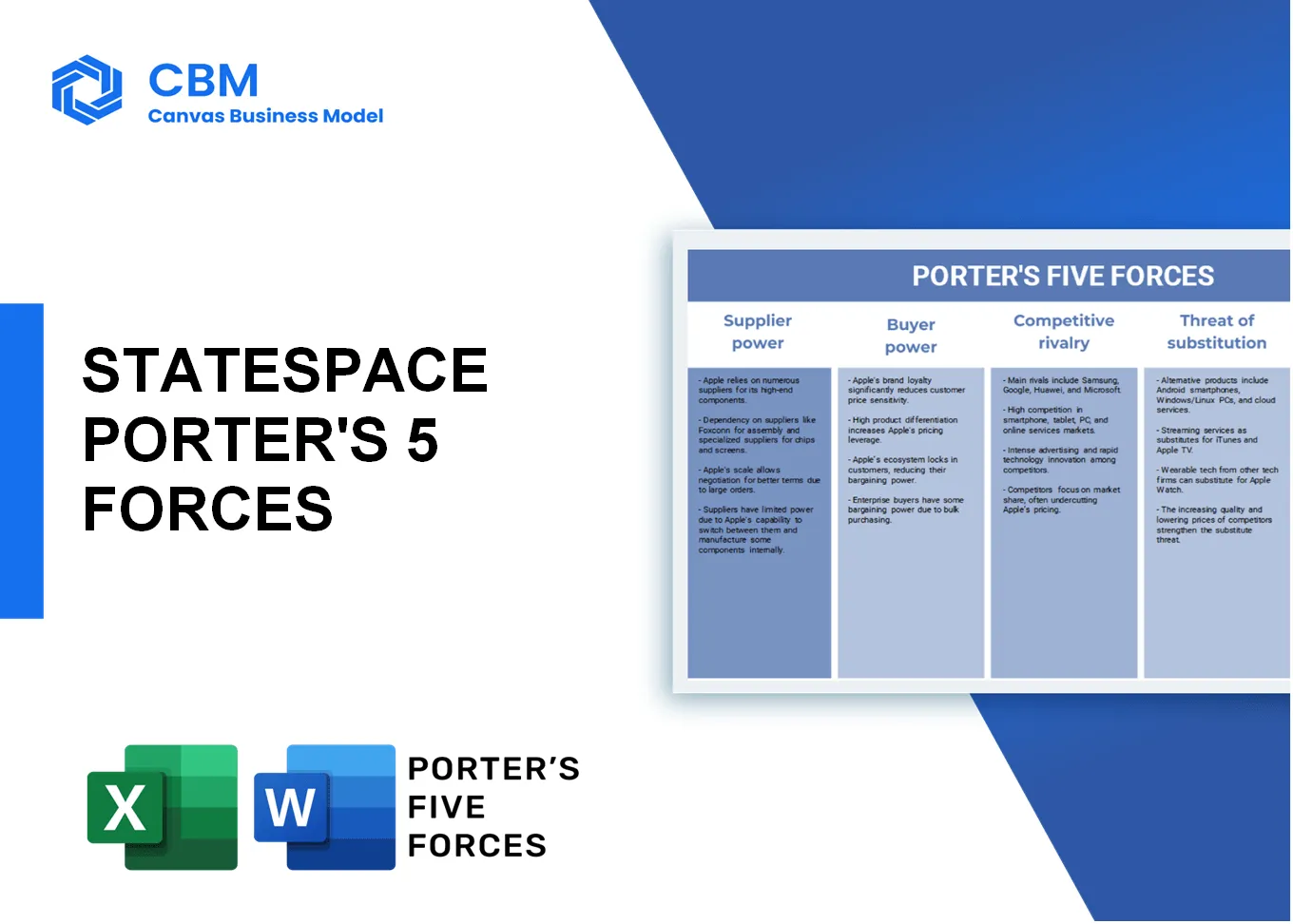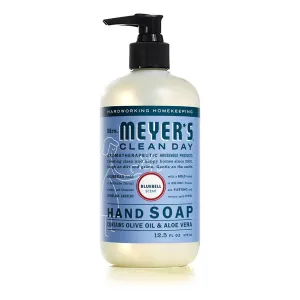In the dynamic landscape of gaming performance analytics, understanding the intricacies of Michael Porter’s Five Forces is essential for navigating challenges and seizing opportunities. This analysis delves into the bargaining power of suppliers and customers, explores the competitive rivalry that shapes the market, and evaluates the threat of substitutes and new entrants vying for a piece of the pie. What factors are at play that influence Statespace's position in the industry? Read on to uncover the compelling insights that could redefine your understanding of this vibrant sector.
Porter's Five Forces: Bargaining power of suppliers
Limited number of analytics software providers
The analytics software landscape encompasses a variety of players, but only a handful dominate the market. According to a report by Statista, as of 2023, the global market for analytics software is estimated to be worth approximately $60 billion, with key providers such as Microsoft, Tableau, and IBM holding significant shares. This limited number of providers increases their bargaining power.
Dependence on technology providers for data integration
Statespace relies heavily on various technology providers for seamless data integration. A survey by Gartner in 2022 indicated that over 75% of organizations with analytics platforms face challenges in integrating data from multiple sources. As a result, technology providers can significantly influence pricing and terms due to this reliance.
Potential for suppliers to switch to competitors
Suppliers in this sector, particularly in software development and data management, have the potential to easily switch to competitors if they perceive better opportunities. In a study conducted by Forrester Research, it was reported that roughly 60% of suppliers actively consider switching providers due to pricing strategies or improved offerings, enhancing their bargaining leverage regarding pricing and services.
Proprietary technology may limit options
Many analytics tools utilize proprietary technology, which restricts options for companies like Statespace. According to a 2023 analysis from IDC, over 40% of analytics software employs proprietary formats that complicate integration with other systems. This creates a necessity for organizations to rely on specific suppliers, further increasing their negotiating power.
Supplier consolidation reducing available choices
The analytics market has seen significant consolidation over the last few years, reducing the choices available for companies. A report by McKinsey revealed that since 2019, there have been over 200 mergers and acquisitions within the software analytics sector. This consolidation reduces competition and empowers remaining suppliers to dictate prices and terms more effectively.
| Factor | Bargaining Power Impact | Statistics |
|---|---|---|
| Limited number of analytics software providers | High | $60 billion global market value |
| Dependence on technology providers | High | 75% face integration challenges |
| Potential for suppliers to switch | Moderate | 60% consider switching providers |
| Proprietary technology limitations | High | 40% use proprietary formats |
| Supplier consolidation | High | 200 mergers and acquisitions since 2019 |
[cbm_5forces_top]
Porter's Five Forces: Bargaining power of customers
Increasing demand for performance analytics tools
The global gaming analytics market is projected to reach approximately $4.5 billion by 2025, growing at a CAGR of around 28% from 2020. As a result, the demand for performance analytics tools such as those offered by Statespace is significantly increasing.
Variety of free or low-cost alternatives available
Various competitors in the market provide free or low-cost analytics tools. For example, platforms like OP.GG and Mobalytics offer basic performance tracking services at no charge, increasing the bargaining power of customers. According to a survey, approximately 45% of gamers reported using free tools to analyze their gameplay.
Customer loyalty driven by user experience
User experience plays a crucial role in building customer loyalty. Statespace has a customer retention rate of approximately 70%, indicating that users favor tools that provide intuitive interfaces and valuable insights. A study reported that 89% of consumers are more likely to stay loyal to brands that prioritize positive experiences.
Ability to provide feedback influences product development
Feedback mechanisms play a vital role in shaping product offerings. Against the backdrop of an industry standard where 70% of companies gather customer feedback, Statespace actively involves approximately 60% of its user base in testing new features before launch. This approach ensures that customer preferences are reflected in product updates.
High expectations for personalized features and services
Today's consumers demand personalized experiences. A report by Salesforce indicated that 76% of customers expect companies to understand their individual needs, while 56% of gamers specifically seek customized analytics. Statespace's inability to meet these expectations could lead to an increased likelihood of churn as customers explore alternative solutions.
| Metric | Value |
|---|---|
| Global Gaming Analytics Market Size (2025) | $4.5 billion |
| CAGR (2020-2025) | 28% |
| Percentage of Gamers Using Free Tools | 45% |
| Customer Retention Rate (Statespace) | 70% |
| Consumers Expecting Positive Experiences | 89% |
| Users Involved in Feature Testing | 60% |
| Customers Expecting Personalized Experiences | 76% |
| Gamers Seeking Customized Analytics | 56% |
Porter's Five Forces: Competitive rivalry
Growing number of companies in performance analytics space
The market for performance analytics in gaming has seen significant growth. As of 2023, the global esports market was valued at approximately $1.38 billion. The performance analytics sector within this market continues to expand, with over 300 companies now operating in this niche.
Established competitors with strong brand recognition
Major competitors in the performance analytics space include:
| Company | Estimated Revenue (2022) | Market Share | Brand Recognition Score |
|---|---|---|---|
| Riot Games | $1.74 billion | 12% | 95 |
| Activision Blizzard | $8.8 billion | 18% | 90 |
| Esports One | $10 million | 3% | 70 |
| Statespace | $5 million | 1% | 65 |
Continuous innovation critical to maintain market share
Recent statistics indicate that companies investing in innovation see a 15% higher market share than those that do not. Statespace has launched several new features in the past year, including:
- Real-time performance tracking
- AI-driven analytics tools
- Integration with multiple gaming platforms
These innovations are essential in maintaining competitive advantage in a rapidly evolving market.
Marketing strategies significantly impact customer acquisition
According to a survey conducted in early 2023, 70% of esports players stated that marketing campaigns significantly influenced their tool selection. The marketing budgets and customer acquisition costs for leading competitors are as follows:
| Company | Marketing Budget (2023) | Customer Acquisition Cost |
|---|---|---|
| Riot Games | $200 million | $50 |
| Activision Blizzard | $300 million | $40 |
| Statespace | $5 million | $100 |
Partnerships and sponsorships with esports organizations intensifying competition
Partnerships are becoming increasingly important in the esports analytics space. As of 2023, around 60% of esports organizations have established partnerships with analytics companies. Key sponsorship deals include:
- Statespace has partnered with Team Liquid, enhancing its visibility.
- Riot Games collaborates with Cloud9 for data-driven performance insights.
- Activision Blizzard has sponsorship ties with FaZe Clan, focusing on analytics-driven strategies.
These partnerships not only boost brand recognition but also create additional competitive pressure in the marketplace.
Porter's Five Forces: Threat of substitutes
Free online resources and community-driven platforms
The rise of free online resources has significantly increased the threat of substitutes for Statespace. Platforms like YouTube and Twitch offer countless videos and streams that provide gameplay analysis, coaching tips, and strategies free of charge. According to a study by Statista, the number of YouTube gaming channels surpassed 50 million in 2022, providing ample access to free content for gamers. Twitch also reported an average daily viewership of over 2.5 million in 2022, creating a strong community dynamic that competitors must contend with.
Mobile gaming apps offering alternative engagement
The mobile gaming sector is booming, with revenues projected to reach $194 billion by 2024 according to Newzoo. Many mobile games come with integrated social features and analytics that can directly compete with Statespace's offerings. For instance, games like Fortnite and Genshin Impact not only engage players but also foster communities, making them substitutes for dedicated performance analytics tools. The rapid adoption of mobile gaming has been evidenced by a 20% annual growth rate in mobile game downloads reported in 2022.
Traditional coaching and training services still relevant
Despite the technological advancements in performance analytics, traditional coaching methods remain a competitive threat. Many esports athletes still rely on personal trainers and coaching services which accounted for $2.6 billion in market size as of 2023. This segment is expected to grow by 10% annually as more players seek personalized coaching experiences and mentorship. Professional coaches in the esports domain can charge between $50 to $150 per hour, posing a significant alternative to software solutions offered by Statespace.
Social media platforms providing informal analytics
Social media platforms like Discord, Twitter, and Reddit have become hubs for gaming analytics and peer feedback. Approximately 70% of gamers use social media to engage with content creators and analyze gameplay. According to a survey by Nielsen, gamers are increasingly turning to social networks for tips and analytics instead of formal tools, which could undermine Statespace's market position. With over 500 million users on Discord and 400 million on Reddit as of 2023, these platforms have a substantial influence on gamers’ decision-making.
New entrants creating niche solutions for specific demographics
The emergence of new entrants in the gaming analytics market poses a further threat of substitution. Startups like Aim Lab and Kovaak's FPS Aim Trainer cater to specialized audiences, focusing on improving specific skills rather than holistic performance analytics. These companies generated approximately $15 million in revenue in 2022 and are expected to see an annual growth rate of 15%. Such niche offerings attract dedicated player bases away from broader analytics platforms.
| Type of Substitute | Market Size 2023 (USD) | Annual Growth Rate (%) | Primary Competitors |
|---|---|---|---|
| Online Resources | > $2 billion | 15% | YouTube, Twitch |
| Mobile Gaming | $194 billion | 20% | Fortnite, Genshin Impact |
| Traditional Coaching | $2.6 billion | 10% | Private Coaches |
| Social Media Analytics | Not directly quantified | 15% (est.) | Discord, Reddit |
| Niche Solutions | $15 million | 15% | Aim Lab, Kovaak's |
Porter's Five Forces: Threat of new entrants
Low barriers to entry for software development
The software development industry has relatively low barriers to entry, particularly when it comes to gaming analytics. According to Statista, in 2022, the global gaming market was valued at approximately $197 billion. The ease of access to software development tools has allowed more companies to enter this space. Open-source platforms and affordable development environments further lower costs for new entrants.
Increasing venture capital interest in gaming analytics
Venture capital investments in gaming-related startups have surged, with companies raising $4 billion in 2021 alone, according to PitchBook. Statespace, being a part of this growing sector, is witnessing increased competition as investors look for innovative solutions that can enhance player performance. In the first quarter of 2022, investments in esports and gaming surged nearly 60% compared to the previous year.
Emerging technologies enabling new approaches
Technologies such as artificial intelligence (AI) and machine learning are becoming increasingly accessible for startups aiming to improve gaming analytics. According to a report from ResearchAndMarkets, the global AI in gaming market is projected to reach $21 billion by 2026, a growth rate of 30% from 2021. This technological shift provides new entrants with tools to offer unique solutions rapidly.
Difficulty in building brand loyalty quickly
Brand loyalty remains a significant challenge in the gaming industry, especially for new entrants. A study from Nielsen indicates that over 70% of gamers prefer established brands when choosing games and gaming tools. Building a client base requires sustained marketing and high-quality product offerings. According to a survey by Newzoo, about 38% of players report they only stick with brands they’ve previously used, making it difficult for new entrants without solid brand recognition.
Market growth attracting a variety of startups and tech companies
The gaming analytics market is experiencing rapid growth, attracting a broad array of startups and technology companies. The global gaming analytics market is projected to grow from $1.56 billion in 2020 to over $6 billion by 2025, according to Mordor Intelligence. This growth results in increased competition and presents new entrants with both opportunities and challenges as they vie for market share.
| Year | Venture Capital Investment ($ Billion) | Global Gaming Market Value ($ Billion) | Gaming Analytics Market Value ($ Billion) | AI in Gaming Projected Value ($ Billion) |
|---|---|---|---|---|
| 2021 | 4 | 197 | 1.56 | 21 |
| 2022 | 6.4 | 219 | 3.44 | 27 |
| 2025 | 8 | 270 | 6 | 34 |
In conclusion, the landscape of performance analytics for gamers and esports athletes is multifaceted and dynamic, influenced by varying forces at play. The bargaining power of suppliers remains impacted by limited options and technology integration dependencies, while customers wield significant influence due to their increasing demand and the availability of alternatives. Moreover, the competitive rivalry intensifies with established brands and continuous innovation, posing a challenge for emerging players. The threat of substitutes looms large, with free resources and traditional coaching still relevant, complemented by niche solutions from new entrants. Ultimately, the threat of new entrants underscores the allure of this growing market, characterized by low barriers and substantial venture capital interest, making it a thrilling arena for innovation and competition.
[cbm_5forces_bottom]




![Professor Oak (CLV) [Trading Card Game Classic] Professor Oak (CLV) [Trading Card Game Classic]](https://www.heelheaven.shop/image/professor-oak-clv-trading-card-game-classic_UGDw1k_300x.webp)







